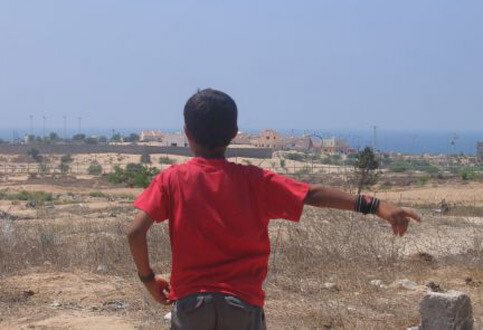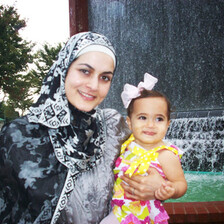Al Jazeera 15 August 2005

A young boy from the Siyafa village looks towards the soon-to-be evacuated settlement of Dugit. (Laila El-Haddad)
Palestinians are greeting Israel’s pullout from the Gaza strip with high hopes but some anxiety, as the first televised images of settlers leaving are broadcast. “Pictures are now being broadcast to the world of what we thought would never happen. The withdrawal is now beginning,” said Palestinian Minister of Information Nabil Shaath earlier on Sunday.
“There is a sense of happiness, relief, pleasure, mixed in with anxiety. The withdrawal is becoming a reality, no longer a conjecture. We are moving form total disbelief to anxious belief,” said Shaath. But he added that there were still many unanswered questions and that coordination between the Israelis and Palestinians was minimal if not non-existent.
Meanwhile, more than 7500 Palestinian security officers re-deployed to positions they held over five years ago on the outskirts of the settlements across Gaza, some as close as 150m away. Palestinian Interior Ministry spokesman Tawfiq Abu Khoussa told Aljazeera.net the Palestinian deployment had been undertaken in coordination with Israel.
Anxiety
In the Central Gaza Strip town of Dair al-Balah, adjacent to the settlement of Kfar Darom, anxiety continued to grip residents just hours before the withdrawal was set to begin. The night before, Palestinian fighters exchanged fire with Israeli soldiers located in the colony. Five Israeli soldiers were injured when an Israeli tank shell accidentally hit a nearby armoured personnel carrier.
“People are counting down the days to withdrawal, but our nerves are on edge. We are afraid that the disengagement will not go so smoothly, and problems break out,” said Um Wisam al-Maani, from within the enclosed area of Maani adjacent to the colony.
“The settlers are going about their daily lives as if they are not leaving tomorrow. They are planting new trees, shopping, and driving their cars around,” her husband, Abdullah al-Maani said. “I am not very hopeful. I think the days ahead will be very difficult. We are worried the settlers may try to burn our houses or harm us in some way; there are no Palestinian security forces to protect us here.”
Up to 4000 anti-disengagement protesters had illegally infiltrated the Gaza settlements, including Kfar Darom, according to Israeli Army Radio. Palestinian residents of the area feared the Jewish protesters might use violence to try to stop the withdrawal.
Expectations
In Gaza city, life seemed normal, if not quieter than usual. Many Palestinians simply did not know what to expect, relying on satellite channels and radio stations to broadcast details of the withdrawal for them. The Palestinian satellite channel was marking the down the days and hours “until liberation” with a ticker.
Mosques in Gaza called on worshippers through loudspeakers to attend communal prayers of thanks, and to pray for the withdrawal of Israeli forces from the West Bank and Jerusalem. At night, sporadic celebrations took place throughout the Gaza Strip.
On the beachfront, the Palestinian Withdrawal Committee, headed by Minister of Civil Affairs Muhammad Dahalan, organised a “street clean-up” event as part of the local campaign to “Reclaim Gaza”.
Hopes
Hundreds of young Palestinians showed up donning caps and white T-shirts stating “today Gaza, tomorrow the West Bank and Jerusalem”, that had been mass-produced and distributed in the run-up to withdrawal. In other areas of Gaza, however, there were no such premature celebrations.
In the northwestern village of al-Siyafa, bordering the settlement triangle of Dugi, Nisanit, and Eli Sinai, Palestinians prepared for what they were told would be a month long closure of their community. As they lined up waiting for Israeli forces to open the gate to their fenced in village, residents said they were excited but worried about the days ahead and what the future might hold.
“People are happy, but very anxious - it’s a period of observation and waiting. We have suffered a lot in the past, but are looking to the future with hope and some fear. What will the days ahead hold - this is what no one knows,” community leader Musa al-Ghul said.
Not celebrating yet
“Will there be real peace, will there be guarantees for our freedom of movement - all this makes us think a million times before we celebrate for sure,” said al-Ghul, as he prepared to transport several bags of vegetables, an electric generator and petrol he brought from Gaza city to use during the closure.
“I look forward to the day the Jews leave this area and I can be free to move within my land once again,” added Siyafa resident Abu el-Abed, as he waited alongside several others amid vast swathes of razed farmland, the red-roofed villas of the soon-to-be evacuated settlements visible in the background.
Nearby was another sign that the disengagement was all but inevitable. An Israeli sniper tower that once forebodingly overlooked the troubled village had been replaced by a tank and a remote-controlled camera linked to an observation room, as the Israeli military gradually withdrew alongside the settlers.
Al-Ghul denied the claim that Dugit was now empty of settlers, however, saying if anything, he had noticed increased activity in the past few days in the isolated colony. “When it comes down to zero-hour, they have to face the hard truth, and they will realise there is no hope for them,” he said.
Holding on
Although infrastructure is beginning to be dismantled, many settlers have decided to remain in their homes, refusing to obey military orders to evacuate, and face forcible evacuation in the coming days and weeks.
“I have no plans to go anywhere. There are many other people still here with me,” said a clearly despondent Avi Farhan, a settler from the colony Eli Sinai in the northern Gaza Strip, across the fence from the residents of Siyafa. “If the Israeli army comes to forcibly remove me tomorrow, I’m staying right here in my house.”
Laila M. El-Haddad is a journalist based in the Gaza Strip. This article was originally published by aljazeera.net and reprinted on EI permission.
Related Links





